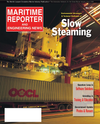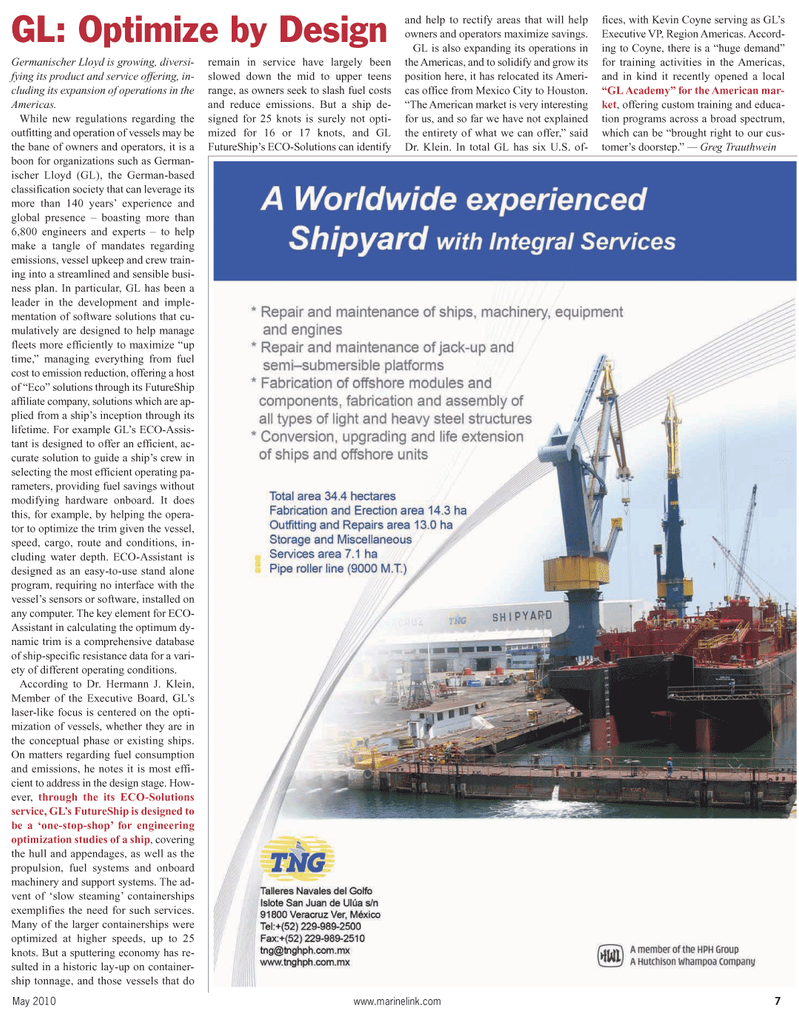
Page 7: of Maritime Reporter Magazine (May 2, 2010)
Read this page in Pdf, Flash or Html5 edition of May 2, 2010 Maritime Reporter Magazine
Germanischer Lloyd is growing, diversi- fying its product and service offering, in- cluding its expansion of operations in the
Americas.
While new regulations regarding the outfitting and operation of vessels may be the bane of owners and operators, it is a boon for organizations such as German- ischer Lloyd (GL), the German-based classification society that can leverage its more than 140 years’ experience and global presence – boasting more than 6,800 engineers and experts – to help make a tangle of mandates regarding emissions, vessel upkeep and crew train- ing into a streamlined and sensible busi- ness plan. In particular, GL has been a leader in the development and imple- mentation of software solutions that cu- mulatively are designed to help manage fleets more efficiently to maximize “up time,” managing everything from fuel cost to emission reduction, offering a host of “Eco” solutions through its FutureShip affiliate company, solutions which are ap- plied from a ship’s inception through its lifetime. For example GL’s ECO-Assis- tant is designed to offer an efficient, ac- curate solution to guide a ship’s crew in selecting the most efficient operating pa- rameters, providing fuel savings without modifying hardware onboard. It does this, for example, by helping the opera- tor to optimize the trim given the vessel, speed, cargo, route and conditions, in- cluding water depth. ECO-Assistant is designed as an easy-to-use stand alone program, requiring no interface with the vessel’s sensors or software, installed on any computer. The key element for ECO-
Assistant in calculating the optimum dy- namic trim is a comprehensive database of ship-specific resistance data for a vari- ety of different operating conditions.
According to Dr. Hermann J. Klein,
Member of the Executive Board, GL’s laser-like focus is centered on the opti- mization of vessels, whether they are in the conceptual phase or existing ships.
On matters regarding fuel consumption and emissions, he notes it is most effi- cient to address in the design stage. How- ever, through the its ECO-Solutions service, GL’s FutureShip is designed to be a ‘one-stop-shop’ for engineering optimization studies of a ship, covering the hull and appendages, as well as the propulsion, fuel systems and onboard machinery and support systems. The ad- vent of ‘slow steaming’ containerships exemplifies the need for such services.
Many of the larger containerships were optimized at higher speeds, up to 25 knots. But a sputtering economy has re- sulted in a historic lay-up on container- ship tonnage, and those vessels that do remain in service have largely been slowed down the mid to upper teens range, as owners seek to slash fuel costs and reduce emissions. But a ship de- signed for 25 knots is surely not opti- mized for 16 or 17 knots, and GL
FutureShip’s ECO-Solutions can identify and help to rectify areas that will help owners and operators maximize savings.
GL is also expanding its operations in the Americas, and to solidify and grow its position here, it has relocated its Ameri- cas office from Mexico City to Houston. “The American market is very interesting for us, and so far we have not explained the entirety of what we can offer,” said
Dr. Klein. In total GL has six U.S. of- fices, with Kevin Coyne serving as GL’s
Executive VP, Region Americas. Accord- ing to Coyne, there is a “huge demand” for training activities in the Americas, and in kind it recently opened a local “GL Academy” for the American mar- ket, offering custom training and educa- tion programs across a broad spectrum, which can be “brought right to our cus- tomer’s doorstep.” — Greg Trauthwein
May 2010 www.marinelink.com 7
GL: Optimize by Design

 6
6

 8
8
